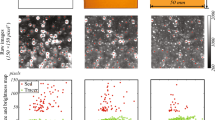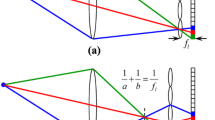Abstract
This paper presents a multi-camera method to reconstruct the instantaneous position of large dispersed-phase particles in systems where the optical depth is of order O(1), with a specific emphasis on problems in sediment transport. Although much work has been performed in multi-camera three-dimensional reconstruction methods, the majority of prior work has been focused on small tracer particles appropriate for single-phase PIV. The large difference in the size between typical tracer particles and suspended sediment (usually 10 to 100 times) gives sediment particles distinct image characteristics, which violates the assumptions made by most 3D reconstruction techniques in current use and thus motivates us to develop a technique to accommodate the unique image signature of sediment particles. Inspired by the work of Maas et al. (1993), Khalitov and Longmire (2002), Spinewine et al. (2003), Knowles and Kiger (2012), this paper introduced a multi-camera thin light sheet imaging method to accurately measure the dispersed phase concentration up to optical densities of close to O(1). The work is an extension of a prior single-camera method (Knowles and Kiger 2012) that utilizes particle image characteristics to identify particles and, when appropriately calibrated, provide a measure of the effective measurement volume thickness. By introducing multiple camera perspectives, stereophotogrammetry methods (Maas et al. 1993; Spinewine et al. 2003) can be combined with the particle image characteristics to provide (1) increased accuracy in determining individual particle locations and (2) increased reliability in identifying all of the dispersed-phase objects in the face of larger increased volume fraction. The method is calibrated through the use of a fixed solid/gel suspension test cell that mimics the optical properties of a solid/water suspension. The static arrangements of the particles allow for a repeatable volume scan of the cell. This is subsequently used to produce an accurate map** of the particle locations within the test volume, which serves as the reference set for evaluating the performance of the new method. Comparisons are made over a range of volume fractions from \(C = 1 \times 10^{-4}\) to \(C = 1.2 \times 10^{-2}\) for a fixed spherical particle size of \(D = 240 \, \mu m\). The new method is able to provide an accuracy of \(2 \%\) up to a volume fraction of \(C \approx 8 \times 10^{-3}\), which is an order of magnitude greater than the single-camera method used previously. Finally, the proposed technique is applied to an oscillatory sheet flow to demonstrate its advantage over the standard 3D-PTV and single-camera methods.













Similar content being viewed by others
References
Adrian RJ (2005) Twenty years of particle image velocimetry. Exp Fluids 39(2):159–169. https://doi.org/10.1007/s00348-005-0991-7
Böhm T, Frey P, Ducottet C, Ancey C, Jodeau M, Reboud JL (2006) Two-dimensional motion of a set of particles in a free surface flow with image processing. Exp Fluids 41(1):1–11. https://doi.org/10.1007/s00348-006-0134-9
Cardwell ND, Vlachos PP, Thole KA (2011) A multi-parametric particle-pairing algorithm for particle tracking in single and multiphase flows. Meas Sci Technol 22(10):105406
Cierpka C, Lütke B, Kähler CJ (2013) Higher order multi-frame particle tracking velocimetry. Exp Fluids 54(5):1533. https://doi.org/10.1007/s00348-013-1533-3
Cui Y, Zhang Y, Jia P, Wang Y, Huang J, Cui J, Lai WT (2018) Three-dimensional particle tracking velocimetry algorithm based on tetrahedron vote. Exp Fluids 59(2):31. https://doi.org/10.1007/s00348-017-2485-9
Deen NG, Westerweel J, Delnoij E (2002) Two-phase piv in bubbly flows: status and trends. Chem Eng Technol 25(1):97–101
Delnoij E, Westerweel J, Deen N, Kuipers J, van Swaaij W (1999) Ensemble correlation piv applied to bubble plumes rising in a bubble column. Chem Eng Sci 54(21):5159–5171. https://doi.org/10.1016/S0009-2509(99)00233-X
Gui L, Lindken R, Merzkirch W (1997) Phase-separated piv measurements of the flow around systems of bubbles rising in water. ASME FEDSM Citeseer 97:22–26
Hergault V, Frey P, Métivier F, Barat C, Ducottet C, Böhm T, Ancey C (2010) Image processing for the study of bedload transport of two-size spherical particles in a supercritical flow. Exp Fluids 49(5):1095–1107. https://doi.org/10.1007/s00348-010-0856-6
Horikawa K, Watanabe A, Katori S (1982) Sediment transport under sheet flow condition. Coast Eng 1982:1335–1352
Ishikawa M, Murai Y, Wada A, Iguchi M, Okamoto K, Yamamoto F (2000) A novel algorithm for particle tracking velocimetry using the velocity gradient tensor. Exp Fluids 29(6):519–531. https://doi.org/10.1007/s003480000120
Khalitov DA, Longmire EK (2002) Simultaneous two-phase piv by two-parameter phase discrimination. Exp Fluids 32(2):252–268. https://doi.org/10.1007/s003480100356
Kiger K, Pan C (2000) Piv technique for the simultaneous measurement of dilute two-phase flows. J Fluids Eng 122(4):811–818
Knowles PL, Kiger KT (2012) Quantification of dispersed phase concentration using light sheet imaging methods. Exp Fluids 52(3):697–708. https://doi.org/10.1007/s00348-011-1100-8
Maas HG, Gruen A, Papantoniou D (1993) Particle tracking velocimetry in three-dimensional flows. Exp Fluids 15(2):133–146. https://doi.org/10.1007/BF00190953
Malik NA, Dracos T, Papantoniou DA (1993) Particle tracking velocimetry in three-dimensional flows. Exp Fluids 15(4):279–294. https://doi.org/10.1007/BF00223406
Mikheev AV, Zubtsov VM (2008) Enhanced particle-tracking velocimetry (eptv) with a combined two-component pair-matching algorithm. Meas Sci Technol 19(8):085401
Nishino K, Kasagi N, Hirata M (1989) Three-dimensional particle tracking velocimetry based on automated digital image processing. J Fluids Eng 111(4):384–391
Ohmi K, Li HY (2000) Particle-tracking velocimetry with new algorithms. Meas Sci Technol 11(6):603
Okamoto K, Hassan YA, Schmidl WD (1995) New tracking algorithm for particle image velocimetry. Exp Fluids 19(5):342–347. https://doi.org/10.1007/BF00203419
Ouellette NT, Xu H, Bodenschatz E (2006) A quantitative study of three-dimensional lagrangian particle tracking algorithms. Exp Fluids 40(2):301–313. https://doi.org/10.1007/s00348-005-0068-7
Poelma C, Westerweel J, Ooms G (2006) Turbulence statistics from optical whole-field measurements in particle-laden turbulence. Exp Fluids 40(3):347–363. https://doi.org/10.1007/s00348-005-0072-y
Ribberink JS, Al-Salem AA (1994) Sediment transport in oscillatory boundary layers in cases of rippled beds and sheet flow. J Geophys Res Oceans 99(C6):12707–12727
Schanz D, Gesemann S, Schröder A, Wieneke B, Novara M (2013) Non-uniform optical transfer functions in particle imaging: calibration and application to tomographic reconstruction. Meas Sci Technol 24(2):024009
Schanz D, Gesemann S, Schröder A (2016) Shake-the-box: Lagrangian particle tracking at high particle image densities. Exp Fluids 57(5):70. https://doi.org/10.1007/s00348-016-2157-1
Seol DG, Socolofsky SA (2008) Vector post-processing algorithm for phase discrimination of two-phase piv. Exp Fluids 45(2):223–239. https://doi.org/10.1007/s00348-008-0473-9
Spinewine B, Capart H, Larcher M, Zech Y (2003) Three-dimensional voronoï imaging methods for the measurement of near-wall particulate flows. Exp Fluids 34(2):227. https://doi.org/10.1007/s00348-002-0550-4
Wieneke B (2005) Stereo-piv using self-calibration on particle images. Exp Fluids 39(2):267–280. https://doi.org/10.1007/s00348-005-0962-z
Wieneke B (2013) Iterative reconstruction of volumetric particle distribution. Meas Sci Technol 24(2):024008
Zhang Y, Wang Y, Jia P (2014) Improving the delaunay tessellation particle tracking algorithm in the three-dimensional field. Measurement 49:1–14. https://doi.org/10.1016/j.measurement.2013.10.039
Author information
Authors and Affiliations
Corresponding author
Additional information
Publisher's Note
Springer Nature remains neutral with regard to jurisdictional claims in published maps and institutional affiliations.
Rights and permissions
About this article
Cite this article
Liu, C., Kiger, K.T. Multi-camera single-plane PIV imaging in two-phase flow for improved dispersed-phase concentration. Exp Fluids 63, 41 (2022). https://doi.org/10.1007/s00348-021-03335-z
Received:
Revised:
Accepted:
Published:
DOI: https://doi.org/10.1007/s00348-021-03335-z




